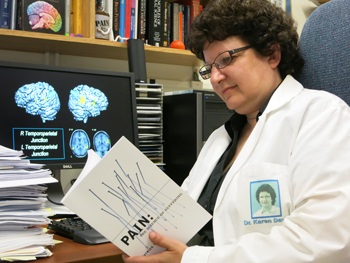
How do you react to pain? Researchers say how you cope is important when determining the best treatment options. (Photo: Fitz-Villafuerte/Flickr)
You’re in the middle of a final exam when you start to feel the onset of an intense, sharp migraine. The pain is so unexpected and quickly tightens around your head like a vice. How do you react?
Do you:
a) Give up on finishing the exam
b) Start answering the questions more slowly, taking breaks when the pain becomes unbearable, or
c) Focus on finishing the exam, answering questions a little faster
Your reaction may indicate what ‘type’ of person you are when it comes to pain.
In a recent study published in the journal PAIN, researchers of the Toronto Western Research Institute (TWRI) discovered that pain will either hinder what you are doing (pain dominates) or cause you to concentrate more on your task to distract you from the pain (attention dominates). The findings further our understanding of the different ways people react and cope with pain.
The group’s previous research on pain and attention revealed a surprising finding. Researchers assumed that pain would cause a person to slow down while completing a task, but the study showed that pain prompted such a variety of reactions that they decided to take a closer look at the data.
“The results were so messy and so varied that we thought we had done the experiment wrong,” said Dr. Karen Davis, pictured below, a senior scientist and head of the division of Brain, Imaging, and Behaviour – Systems Neuroscience of TWRI who has a special interest in pain research. “But when we took a closer look at the data, that’s when we found the first clue that the brain might have different ways of responding to pain.”
What Davis and her previous post-doctoral fellow David Seminowicz discovered was that some participants, rather than slowing down when they felt pain, actually got faster at finishing the prescribed task. These participants also said that the task was a “distraction” from the pain, or that the pain caused them to try harder at the task.
Pain reaction
To determine whether this observation was an anomaly or a measurable characteristic, Davis and her team then conducted a study to specifically investigate if people could be categorized into one of these two “pain reaction” types.
“Many studies show that pain often competes for a person’s ‘attention’ resources,” said Davis. “So it was interesting to us to find that, for some, a task can actually focus those resources away from pain.”

In the latest study, Davis and her current post-doctoral fellow Nathalie Erpelding, recruited 80 healthy participants.
They were asked to complete numerical exercises by looking at boxes of numbers and identifying either the box with the number of highest value, or the box that had the most numbers in it. While the participants completed the exercises, researchers applied a pain stimulus to the person’s forearm and measured how the stimulus affected the person’s response time to complete the numerical task.
As they had seen in their earlier study, researchers observed a difference among participants that helped categorize them into one of two groups: A faster performance in the task where attention dominates over the pain, which they labelled A-type; or a slower performance where pain dominated over the task, which they labelled P-type.
Davis and Erpelding then used imaging technology to examine whether the participants’ brain structure could account for this marked difference in reactions. Does the brain of an A-type individual look different from that of a P-type?
Magnetic Resonance Imaging (MRI) results revealed that structural and functional brain differences did exist between the two groups. Compared to the A-type brains, the P-type brains had more gray matter – the area related to information processing –in the regions of the brain associated with pain.
Also, the brain networks associated with sensory functions and detecting important events like pain, were more strongly connected in the P-type than in the A-type brains. In contrast, in the A-type brains, there were more effective white matter connections with areas of the brain that have motor and cognitive functions that help people perform a task even when experiencing pain.
“We were really excited by these findings,” said Davis. “Not only because they confirm that people have different ways of coping with pain, but also because they indicate the brains between these groups are actually different. This allows us to potentially develop a ‘pain profile’ where we could classify people into one group or another based on these structural differences, and treat them accordingly."
Yes, it hurts! But so what?
But why would your reaction to sudden pain matter?
A study on acute pain such as this is a first step to better understanding chronic pain. Sufferers of chronic pain can have a decreased ability to perform many tasks, and this ability can deteriorate over time. The findings provide a general framework of the variations that exist in brain connections and in the future may help health practitioners develop personalized pain therapy based on a person’s behaviour and brain structure.
The next step in this area of research is to find out whether brain areas controlling these responses are malleable and if they can be changed by treatments such as cognitive behavioural therapy (CBT) or brain stimulation.
“It is quite phenomenal that we were able to find the areas in the brain that reflect the different behaviours when dealing with pain,” said Davis. “There are vast individual differences in the pain system and in the coping system, and we need to find out the different ways that people are wired so we can treat those differences. This research is getting us closer to that point.”
In the photo above, right, is Dr. Karen Davis, senior scientist and head of the division of Brain, Imaging, and Behaviour – Systems Neuroscience of TWRI.(Photo: UHN)
